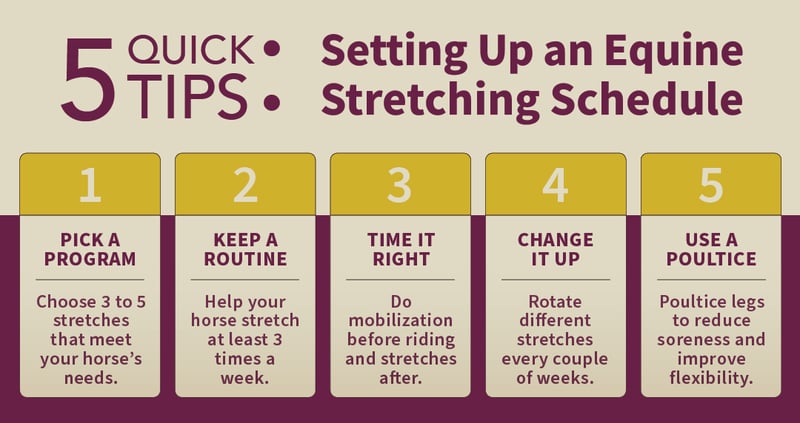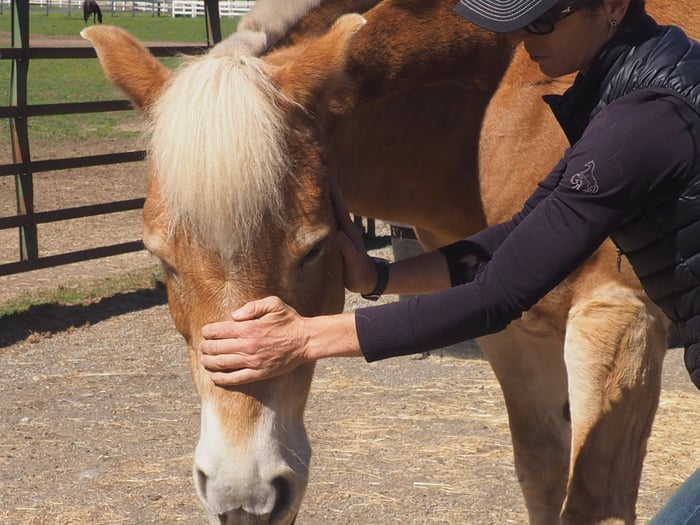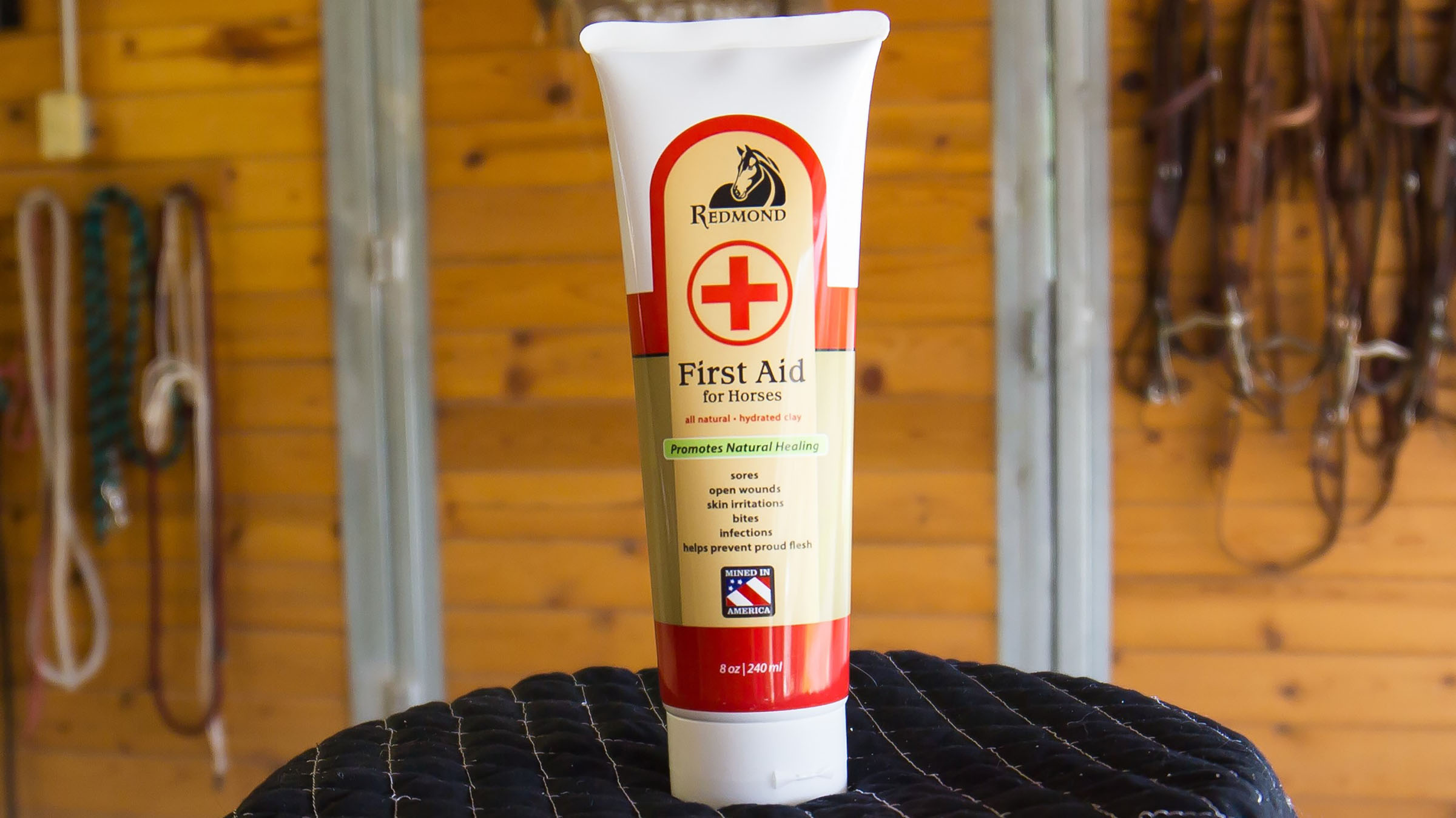Pros Share Tips & Answer Questions About Horse Stretches
June 15, 2023
Pros Share Tips & Answer Questions About Horse Stretches
Want your horse to move like a pro? Try stretching him like one! Most horse owners know stretches are good for equine athletes and believe they should be doing them, but many have questions about the process. How often do horses need stretching? What kind of stretches should they do? When should they do them?
Hold those thoughts and breathe while we get some sage advice—and links to helpful instructions—from two experts who can help you help your horse stretch more, stress less, and stay supple and sound. But first, let’s introduce our guests.
Meet the Experts
Jec Ballou is a horse trainer, author, and owner of Jec Ballou Fitness & Performance. Her well-known books on equine stretching and fitness help horse owners get their partners in their best shape. Jec’s expertise in equine exercise physiology and focus on biomechanics and athleticism also enable horses and riders to work better together.
Dr. Melissa Shaver is a vet with Equine Performance Solutions. She practices alternative sports medicine therapy for horses, with a focus on acupuncture, manipulation, and joint support. She also utilizes modalities such as cold laser, red light therapy, and shock wave. Melissa's hands-on approach to medicine has helped her learn the finer points of keeping horses healthy and limber.
FAQ About Stretches for Horses
Here are nine questions people often pose when considering or queuing up an equine stretching regimen. Helpful advice and tips from Jec and Dr. Shaver follow on when and how to stretch a horse.

Q. Is it good to stretch your horse? What are the benefits of equine stretches?
Dr. Shaver: Frequently stretching your horse’s muscles increases mobility and helps the muscles be less painful the next time you go riding. Specific benefits of stretch exercises for your horse include:
- Improved flexibility.
- Better range of motion.
- Improved stability.
- More comfortable mobility.
- Healthier tissue, which means your horse is less prone to injury.
- Fewer behavior problems because your horse feels more comfortable.
- Better job performance.
Q. Should you stretch your horse before or after riding?
Jec Ballou: Do mobilization maneuvers on your horse before you ride and stretches after you ride.
Mobilization is gentle, non-pulling and non-twisting maneuvers (like belly lifts, shoulder circles, and wither rocking) performed on a horse before warming up. These moves wake up or stimulate nerves and soft tissue, particularly around joints. They help loosen areas of soft tissue that are stuck by inviting the body to activate them.
Active stretching is performed after the horse’s body is warmed up and loosens stuck areas by using physical manipulation or force.
Dr. Shaver: Stretches are most beneficial after a workout. Once the tissue is warmed up and has blood flow to it, that’s when you can get the best motion enhancement. A horse is actually more prone to injury and tissue damage if you stretch soft tissue and get it movable and loose before work. But stretching afterward? That helps it move better and have longer-lasting flexibility the next time your horse exercises.
Q. How do you loosen up a stiff or sore horse?
Jec Ballou: For a stiff or sore horse, I recommend moving them around at a brisk walk for 10 minutes before attempting any kind of stretches. You can also wait until the end of your session to perform them.
Dr. Shaver: Most of the time if a horse refuses to stretch, it’s because something is uncomfortable. So don’t argue with your horse about stretching. If your horse is stiff and they resist or don’t want to move into a position, don’t force them. Trying once or twice and encouraging with treats is fine, but if they still don’t want to, don’t force it.
Redmond Product Tip: Natural Simply Clay equine poultice is super effective at relieving stiff or sore muscles and stocking up. Our hydrated clay improves blood circulation and draws excess fluid while cooling hot muscles and reducing inflammation. It’s premixed and easy to use, so you can apply it straight to your horse's legs or other muscles. Works great before exercise to keep legs cool and tight. Or use it afterwards to speed up a complete recovery.
Q. Do stretches help treat horses with sore backs?
Dr. Shaver: I see many horses with back pain, and spine stretches are commonly used as an adjunct to treatment. They help alleviate pain from soreness due to conditioning or a lack of conditioning and exercise. Carrot stretches are especially useful to loosen up a horse's neck and back. You can get your horse into many positions simply by directing it around with a carrot.
Q. Is it okay to use treats to encourage horse stretching?
Dr. Shaver: Offering treats during stretching exercises is fine, but you do need to be careful about how you offer them and how many. For most horses, a single long carrot can be used to do both sides, neck, and back. You can safely give a horse a carrot 3-5 days per week during stretching. For insulin resistant horses, carrots are too high in sugar. For those horses I use low-starch treats, celery, and in-shell peanuts.
Also, some horses get nippy with treats. If you have a grabby horse, you might train it by touch to go into a position and then put the treat on the ground. You can also use long treats (like a carrot) so your horse doesn’t accidentally bite you.

Q. What basic stretches can I do with my horse?
Jec Ballou: You don’t need to do every possible stretch with your horse every day. Just choose three to five that are the most relevant to your horse’s needs. And remember, mobilizations are done before warmup and stretches come after. Here are some basic exercises I recommend doing routinely.
Horse Mobilization Maneuvers
- Horse shoulder circle stretches
- Wither rocking (described in my book 55 Corrective Exercises for Horses)
- Belly lifts (Demonstrated at the 4:20 mark in this video)
Equine Stretching Exercises
- Carrot stretches (for horses with sore backs and necks)
- Tail traction (horse tail pull stretch)
- Poll Flexion
Q. How do you safely perform horse leg stretches?
Dr. Shaver: With limb stretches, you’re often in an awkward situation and can get yourself or your horse in trouble if you do them incorrectly. Horses are reactive and may have their attention drawn away, and it’s usually the person that winds up getting their foot stepped on or otherwise hurt. Make sure you know the horse, can read their body language, and the horse is comfortable with what you’re doing.
Jec Ballou: My main advice is to not attempt or insist on performing stretches if/when a horse is anxious, fidgety, or otherwise not paying attention. Stretching is not something we can force to happen. It is imperative to take the time to develop a good routine with your horse so he begins to know what to expect and relaxes into the daily routine. For safety, be sure to keep your head away from his knees or legs. Be alert and use a soft grip when lifting and stretching horses' legs; do not hold tightly in case the horse braces or pulls the leg away quickly. Encourage all movements with the horse to be smooth and gentle.
Q. How often should you do stretches with your horse?
Jec Ballou: I recommend stretching horses three times per week. When done before riding, these stretches can activate the horse's postural muscles and prime him to use his body well during your riding session.
Dr. Shaver: How often you should stretch a horse depends on what limiting factors it is experiencing. If a horse has back pain, which is quite common, I recommend performing stretches after every ride.
Q. How often should I change my horse's stretching routine to stay effective?
Jec Ballou: The benefits of horse stretches build on themselves through consistency of practice over time. There is a cumulative gain. If, after a time, it seems like your horse is getting robotic about these maneuvers or just not getting as much out of them, it is time to alter your routine and employ a new batch of movements. About every two weeks is a good time to switch to a new batch of three to five exercises.
Consistency Delivers Results
If you’re struggling to stretch your horse regularly or are just not sure your efforts are working, Jec says to be patient and trust the process.
“Sometimes riders cannot tell if the stretches are immediately accomplishing anything and are tempted to abandon them," she said. "Again, stretches have a cumulative positive benefit for the horse's neuromuscular system that is not always immediately evident from the outside. The results will be in the gradual improvement over time in joint stability and the quality and ease of movement.”
So head to the paddock with your pardner and limber up! Maintaining a consistent stretching routine will keep your horse mobile and do you both good in and under the saddle.
If you're looking for additional ways to reduce inflammation and keep your horse lithe, horse poultices are a great tool. Click below to find out more.
Learn More
- Bentonite clay makes an excellent poultice. Learn the benefits of bentonite clay for horses and why it works.
© Redmond Equine 2023. All rights reserved.
Related posts

Redmond First Aid: Best Wound Care for Horses
Horse injuries happen! Fly bites and wounds occur on horses' legs and other areas. Be prepared with Redmond First Aid horse wound care and healing...
September 13, 2024

Poultice for Horses: How to Reduce Swelling in Legs
Learn when and how to apply the best clay poultice for horses to reduce swelling in legs and help prevent injury.



